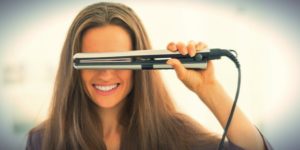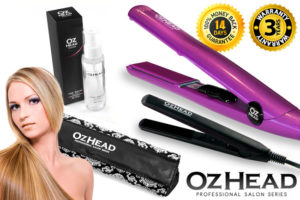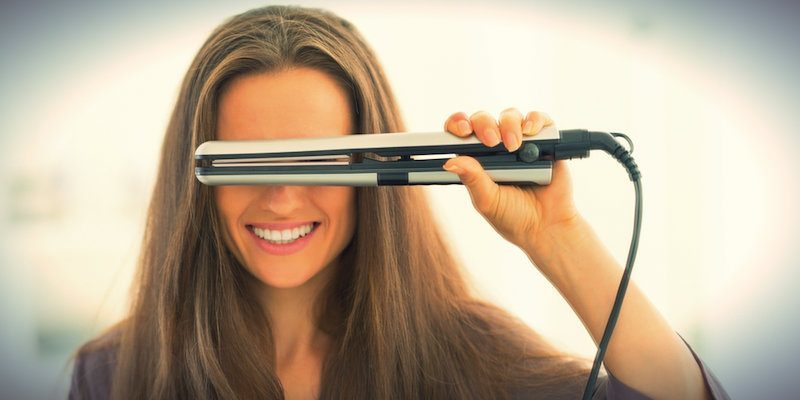As surprising as it may sound, cosmetics and styling often involve a large amount of science. Whether it be producing safe makeup or coming up with effective shampoos and moisturizers, science is everywhere. Hair straightening is one such technique that relies heavily on the basic scientific properties of hair.

Hair is made up of a protein known as keratin. Keratin is composed of long chains of amino acids. Along with hair, nails and teeth enamel are also made up of keratin. Hair, nails, and teeth have one important factor in common — they are all strong.
It is extremely difficult to break a strand of hair apart without a pair of scissors. No amount of twisting, pulling, rubbing, or even hammering can do anything to hair.
The strength of hair can be attributed to a special property unique to proteins like keratin, which are made up of a large number of sulfur-containing amino acids. Sulfur atoms, from adjacent chains of keratin, bond together to form disulphide bonds. These extra bonds make the fibers that have keratin very strong. In addition, they ensure that the position of the keratin molecules remains fixed, such that the shape of the hair fiber stays the same.
Naturally, this is a good property since hair — especially long hair — is normally subjected to a large amount of stress, and one would not want hair breaking or changing its shape because of this everyday wear and tear. However, when people do want to change the shape of their hair — get rid of curls, add curls, make it wavy, make it straight — these disulphide bonds pose a great problem. Most hair-straightening techniques, therefore, target these bonds. An easy method of breaking these bonds is using heat. This brings us to what is probably the most common technique for straightening hair — the flat iron.

The plates of the iron are usually heated to high temperatures, generally between 300 and 500 degrees Fahrenheit.
When hair is passed through the iron quickly, while being held tight and straight, the extreme heat causes the disulphide bonds to break. This breakage allows the keratin chains to move around slightly and assume a position that results in straightened hair. When the hair cools down, the disulphide bonds between the keratin are reformed. Because the keratin molecules are in different positions when the bonds are reformed, the hair stays in the straightened shape for a long period of time. As most people who use flat irons know, this method of straightening hair is not permanent.
Exposure to moisture causes the hair to revert back to its original shape. Permanent hair straightening techniques use harsher methods, with chemicals, to break the disulphide bonds and reform them. The disulphide bonds cannot be broken apart by oxidizing agents, which are acids, but can be broken apart by strong reducing agents, which are bases. Alkaline solutions, therefore, are applied to hair to break apart the disulphide bonds. The hair is then held straight and acidic solutions are applied to it.
The acid neutralizes the base, stopping the disulphide bond cleavage reaction and allowing the disulphide bonds to reform in new positions. Although all chemical hair-straightening techniques have this same basis, each has a slightly different mode of action on the hair. Alkaline hydroxides are the harshest and most rapid agents for breaking the disulphide bonds; usually, either sodium hydroxide or calcium hydroxide is used for this purpose. Along with breaking the disulphide bonds, these solutions also cause the hair to swell. Since they are so harsh, these chemicals should not be left in the hair for more than 10 minutes, as they can cause severe damage to the hair and scalp if not used properly. Hair is usually treated with a cream to protect it from the caustic effects of these chemicals before applying the alkaline hydroxides. Thoroughly washing off the solutions allows the reaction to stop and the disulphide bonds to reform, sealing the hair in its new, straightened position.
Solutions containing thioglycolate are safer to use. Thioglycolate has a rather unpleasant odor, but since it is much less harsh than alkaline hydroxides, it is a more popular method for hair straightening. Thioglycolate contains a thiol (-SH) group, and dissociation of the hydrogen atom from the sulfur creates a thiolate (-S-) ion. Thiolate ions are good reducing agents and help break the disulphide bonds. This method generally takes much longer than alkaline hydroxides. Also, a strong oxidizing agent, such as hydrogen peroxide, has to be applied after thioglycolate treatment in order to stop the reaction and help the bonds reform.
Another method is the use of bisulphate-containing solutions. These, too, can act as reducing agents. They work slightly better than thioglycolates and are safer than alkaline hydroxides. Although chemical hair straightening techniques are popular, scientists are now trying to come up with a way to attack this issue from its roots.
According to a November 2005 article on the Telegraph, scientists from L’Oreal in Paris discovered that a curve-shaped hair follicle gave rise to curly hair while a straight one gave rise to straight hair. The article further states that by understanding what process in the body determine the shape of the hair follicles, scientists could develop a drug to alter the shape of hair follicles and, ultimately, hair. As of now, no such pill exists, and flat ironing or using chemicals are the only two ways to straighten curly hair.
Click here to pay attention more the best hair straightener products

Be First to Comment